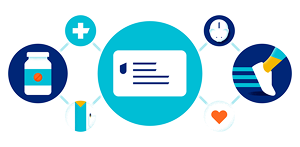It’s a fact of life: Kids get sick, and it tends to happen at the most inconvenient times. Maybe it’s the night before a big family vacation, or while you’re driving across the country. You can’t contact their pediatrician conveniently in either case. (That’s a type of doctor that treats children.)
Fortunately, you’re not out of luck.
Telehealth offers families easy access to medical care from the comfort of their own home. Your child can even stay in their pajamas while being seen via secure video feed with a doctor.
Telehealth appointments are often available 24/7, so you can potentially avoid a trip to urgent care or the emergency room when it’s outside of office hours. And you may not have to cancel that vacation or cross-country trip after all.
Learn how telehealth can help your entire family — especially if you have kids.
Enter your ZIP code to find the virtual care options available in your area.
What is telehealth?
Telehealth, also called telemedicine or virtual care, is the use of technology to allow you to be treated by a healthcare provider without going into their office. A telehealth appointment could be done with:
- General medicine doctor
- Dermatologist (skin doctor)
- Mental health professional
Typically, you do a telehealth call through a secure web portal or app that’s installed on one of your devices. You need an internet connection and a smartphone (data rates may apply), tablet or computer with a video camera to do a telehealth visit.
What are the benefits of telehealth for families?
Convenience and access are a couple of the biggest benefits of virtual pediatric visits — as well as appointments for parents. Here are a few more:
- They can take place outside of normal office hours.
- They eliminate the transportation hassle and time, which also means that your child can see a provider at a facility that may be farther away without a long drive.
- You don’t have to sit in a waiting room with potential exposure to other illnesses.
- You may be able to schedule a virtual visit sooner than an in-person visit, depending on the service or provider.
During a virtual visit, a provider can help determine whether your child needs to be seen in person.
If it’s outside of office hours, they can advise you to take your child to urgent care or the ER — or assure you that it’s all right to wait to have your child be seen by their doctor the next day or even in a few days.
What health conditions can be treated using telehealth?
You might be surprised at the number of health conditions that can be treated virtually.
Nonemergency medical conditions:
- Cold symptoms, such as a runny nose
- Earache
- Sore throat
- Vomiting and diarrhea
- Prescription refill
- Rash or skin problem
- Pink eye
- Mental or emotional health concern
Chronic illness management: If your child has a chronic illness or condition, such as asthma, that requires frequent follow-ups or medication checks with their care team, virtual visits may offer a convenient way to facilitate these.
Specialist consults: More and more specialists are doing virtual visits, which greatly expands your family’s access to nonlocal healthcare providers. For example, if you live in a rural area, it may be difficult to travel to have your child see a specialist at an urban hospital or academic facility in person.
Other medical services: Physical therapy, speech therapy and nutritional counseling are examples of other medical services that may be offered via telehealth.
Have a busy schedule? Learn how virtual care could be a more convenient option.
What do I need to do to get ready for a virtual pediatric visit?
Check with your provider to see if there’s any paperwork to fill out online before the visit. For example, they may let you check in online to verify medications, complete any forms and confirm insurance information.
Make sure that you have the equipment you need ready to go:
- Check that your internet connection or wireless signal is strong.
- Test your audio and video.
- Be sure the devices you’re using are fully charged or plugged in.
- Choose a comfortable, well-lit place in your home.
Turn off the TV or music and make sure the room is quiet. Position the video camera so that the doctor can see you and your child. Your child can sit on your lap or next to you.
Talk to your child in an age-appropriate way about what’s going to happen and let them know that they need to stay on the call long enough for the doctor to see them. For example, school-age children who have experience with remote learning will likely already be comfortable with a video call.
What will happen during the telehealth call?
Virtual visits are similar in format to in-person visits. Be ready to summarize your concerns and your child’s symptoms, including duration, intensity and frequency.
If your child has a fever, take their temperature beforehand. Let the doctor know if you’ve given your child any medications, including over-the-counter ones.
The doctor will observe your child’s activity level, breathing, interaction and general state of health. They’ll also be on the lookout for any visible symptoms, such as a rash.
They will ask you and your child (depending on their age) questions and then recommend any next steps. For example, the doctor may recommend that your child stay home from school, rest and drink extra fluids.
They may suggest that you follow up either with another telehealth call or an in-person visit if their symptoms don’t improve within a few days. You can then wrap up by asking any further questions and confirming any follow-up steps.
Want to avoid waiting rooms? Learn more about virtual visit options, or call a licensed insurance agent at 1-844-211-7730 for more information.
For informational purposes only. This information is compiled by UnitedHealthcare, and/or one of its affiliates, and does not diagnose problems or recommend specific treatment. Services and medical technologies referenced herein may not be covered under your plan. Please consult directly with your primary care physician if you need medical advice.
Compliance code:
51829-X-1224








